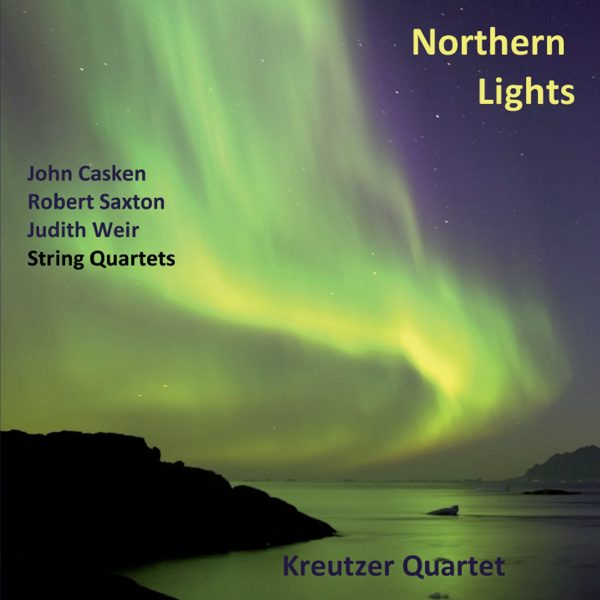International Record Review
The three late-twentieth-century quartets recorded here highlight three distinct creative personalities, and growing acquaintance with the Kreutzer Quartet’s strong performances of them reveals their powerful individuality.
John Casken’s Second Quartet seems to follow a very traditional four-movement structure, one that even Haydn might have recognized, though he would likely have been bemused by the composer’s expressive indications. For the first movement, we have ‘with piquant verve’: this opening Allegro features kaleidoscope oscillations of mood and texture. The music will often settle into dense, four-part lyricism, only to surge into spiky life again. The second movement is surely a scherzo, and is marked ‘with jazzy obstinacy’. The slow movement is the longest, and successfully grips one throughout. Though predominantly subdued, there are song-like fragments punctuated by skitterings and flitterings; maybe these relate in some unspoken way to the marking ‘with haunted fascination’. Traditionally again, the finale is lighter-hearted, a kind of perpetuum mobile with even some moments of tune and accompaniment, all marked ‘with playful determination’. Casken’s quartet certainly adds up to an impressive whole.
As does, in a very different way, Judith Weir’s. Its three continuous movements last only 13 minutes, and I hear them as a kind of progression, from static initial keening, then with some Scotch snaps developing, then with the swaying rhythm of the lower strings at the start of the middle movement expanding outwards to all parts, and culminating in the short Presto finale, a will-o’-the-wisp of a movement that is a kind of sotto voce dance to constantly pulsing rhythms. This is all done with Weir’s characteristic mixture of austerity and lean lyricism: each movement, in fact, has its origin in an earlier Weir song. I hope she writes another quartet soon.
Robert Saxton’s quartet, Songs, Dances and Ellipses is perhaps a slightly tougher nut and it is interesting that he eschews the abstract title in favour of something more specific: singing and dancing do indeed seem to provide one clue, with the first and second movements given over to each notional activity in turn, and the last movement marked ‘dancing, quick’. However this is a five-movement piece, and at its heart is a darkly meditative ten-minute slow movement: out of this, there is a progression back to speed and light. The ‘ellipses’ of the title are an astronomical reference but refer to a structural principle, that of speeding up as we reach an apex… I haven’t yet felt this in operation convincingly, or quite felt the work to function as an organic whole, but maybe this is just a matter of time.
I’m not sure that the title ‘Northern Lights’ is hugely helpful, though admittedly Weir has Scottish ancestry, and Casken has written a lot of music with Northern affiliations. The booklet notes, though, are entirely helpful. It has taken a long time for this issue to reach the market: one of the pieces was recorded a decade ago. The other two are of not much more recent vintage, but it was worth the wait.
@divineartrecordingsgroup
A First Inversion Company
Registered Office:
176-178 Pontefract Road, Cudworth, Barnsley S72 8BE
+44 1226 596703
Fort Worth, TX 76110
+1.682.233.4978





![Listen to the full suite of Marcel Dupré’s Variations Sur un Noël, Op. 20 from Alexander Ffinch’s #Expectations release today! listn.fm/expectations [in bio]](https://scontent-dfw5-1.cdninstagram.com/v/t51.71878-15/588904367_2327488161082898_8709236950834211856_n.jpg?stp=dst-jpg_e35_tt6&_nc_cat=105&ccb=7-5&_nc_sid=18de74&efg=eyJlZmdfdGFnIjoiQ0xJUFMuYmVzdF9pbWFnZV91cmxnZW4uQzMifQ%3D%3D&_nc_ohc=gQOLjaATqEIQ7kNvwFWHoE-&_nc_oc=AdnVFy-hhvXmXPBGyCKn6RB1ij_Pw8hhu69eY8lIPdtCiOum2AmAFI6gsRJodqnHmBg&_nc_zt=23&_nc_ht=scontent-dfw5-1.cdninstagram.com&edm=ANo9K5cEAAAA&_nc_gid=8zGFuhQQG800PrUUH4xdeQ&oh=00_Afn3p2qZM-DNxcFIFX9i-cyhIq-5wv4xByf0kRBBqbbnJg&oe=6947592A)

![“the ‘Manteca’ Paraphrase – a rare foray into the two-piano medium but here played double-tracked – exudes a panache of which Dizzy Gillespie would surely have approved.… [a] recital well worth investigating.” —Gramophone Magazine with high praise for Ophelia Gordon's debut release, Kapustin: Between the Lines!](https://scontent-dfw5-3.cdninstagram.com/v/t51.82787-15/598796470_18303255136283342_540941604740887837_n.jpg?stp=dst-jpg_e35_tt6&_nc_cat=108&ccb=7-5&_nc_sid=18de74&efg=eyJlZmdfdGFnIjoiRkVFRC5iZXN0X2ltYWdlX3VybGdlbi5DMyJ9&_nc_ohc=sFsWUr2jc5wQ7kNvwGNEZDI&_nc_oc=AdnMwFpIVYt06XO6Wbum_p5VAcJgSG3feKp3qXXodbhqYnZlzKFroM1cbV1WSSOHU_I&_nc_zt=23&_nc_ht=scontent-dfw5-3.cdninstagram.com&edm=ANo9K5cEAAAA&_nc_gid=8zGFuhQQG800PrUUH4xdeQ&oh=00_AfmTWrSddsUQ1dRRZpnNZQ28SpcfX0SObZizLwzlPM-tmg&oe=69476BC4)




